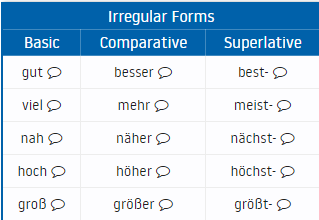Adjectives in German Grammar

Adjectives in German(Adjektive) are describing words. They give us more information about a person, place or thing. There are three types of adjectives in German: predicative, adverbial and attributive. These types not only dictate how we form the comparative and superlative of an adjective, but also if and how we need to decline it — so it’s good to get familiar!
Adjectives in German Grammar
Adjectives (Adjektive) are describing words. They give us more information about a person, place or thing. There are three types of adjectives in German: predicative, adverbial and attributive. These types not only dictate how we form the comparative and superlative of an adjective, but also if and how we need to decline it — so it’s good to get familiar!
Types of German Adjectives
We can divide German adjectives into three types: predicative, adverbial and attributive.
Example

- Predicative adjectives (prädikative Adjektive) come after the verbs sein, bleiben and werden. Predicative adjectives are invariable; this means that their form stays the same regardless of the gender and number of the noun they’re describing.
Example: Der Clown ist lustig.
- Adverbial adjectives (adverbiale Adjektive) come after all verbs apart from sein, bleiben and werden. They are also invariable.
Example: Der Clown springt lustig herum.
- Attributive adjectives (attributive Adjektive) come before nouns and they have to be declined. This means that we have to change the adjective ending according to the case (nominative, accusative, dative, genitive), gender (masculine, feminine, neuter) and number (singular or plural) of the noun.
Examples: Er ist ein sehr lustiger Clown.
*nominative case, masculine singular noun = -er ending
So einen lustigen Clown habe ich noch nie gesehen. .
- *accusative case, masculine singular noun = -en ending
-
Comparative and Superlative Adjectives in German Grammar
German uses comparative adjectives (Steigerungsformen) in the same way as English; to make comparisons or express superlatives.
Like in English, German adjectives have three comparative forms:
- basic (positive Form)
- comparative (Komparativ)
- superlative (Superlativ)
Example: schön – schöner – am schönsten .
Example

Comparisons with Basic Adjectives
In German we use basic adjectives with so … wie to make comparisons.
Example: Maria läuft so schnell wie Susanne. .
We can also use the following structures to make comparisons with basic adjectives:
- genauso … wie
- nicht so … wie
- fast so … wie
- doppelt so … wie
- halb so … wie

Comparatives in German Grammar
The comparative (der Komparativ) compares two people, places or things. To form the comparative in German, we add -er to the basic form of the adjective.
Examples: schnell → schneller .
klein → kleiner .
Unlike English, all German adjectives are formed with -er and never with mehr.
Examples: interessant → interessanter .
not: mehr interessant
schwierig → schwieriger .
- not:
mehr schwierig - The comparative is followed by als (= than).
Examples: Friederike läuft schneller als Maria. .
Maria läuft langsamer als gestern. .
Superlatives in German Grammar
The superlative (der Superlativ) compares people, places or things against all others in the same group or category. With the superlative, we can express the highest degree of something.
In German, the way we form the superlative depends on the type of adjective:
- Adverbial Adjectives: Superlative with am
When an adjective describes a verb (but not sein, werden or bleiben), we form the superlative by placing am in front of the adjective and adding the ending -sten.
- Example:
Friederike läuft am schnellsten. .
- Attributive Adjectives: Superlative with the definite article
When an adjective comes after a noun we form the superlative by placing the definite article in front of the adjective and adding the ending -ste.
Example: Sie ist die schnellste Läuferin. .
- Predicative Adjectives: Superlative with am or the definite article
When the adjective follows the verb sein, bleiben or werden we can form the superlative with am or with the definite article.
Examples: Diese Läuferin ist am schnellsten. .
heiß – heißer – am heißesten .
- The e of the unstressed ending el/bel is removed in the comparative, but not in the superlative.
Examples: edel – edler – am edelsten .
flexibel – flexibler – am flexibelsten .
But: The e remains when the ending –el is stressed and for the ending ell.
Examples: fidel – fideler – am fidelsten .
originell – origineller – am originellsten .
Irregular Comparative Forms
A handful of German adjectives have completely irregular comparative and superlative forms:

Do I need to decline German comparatives?
Yes! We have to decline comparative and superlative adjectives when they come before a noun.
This means that we have to add an ending to the comparative and superlative forms that corresponds to the case (nominative, accusative, dative, genitive), gender (masculine, feminine, neuter) and number (singular or plural) of the noun.
Examples: Maria ist eine schnellere Läuferin als Susanne. .
comparative ending -er + nominative feminine singular ending -e
Friederike ist eine der schnellsten Läuferinnen in unserer Klasse. .- superlative ending -ste + genitive feminine plural ending -n
- Then at last you can improve your German with Learning German App. In addition you can get the best German Keyboard Translator for an accurate and fast translation.


























